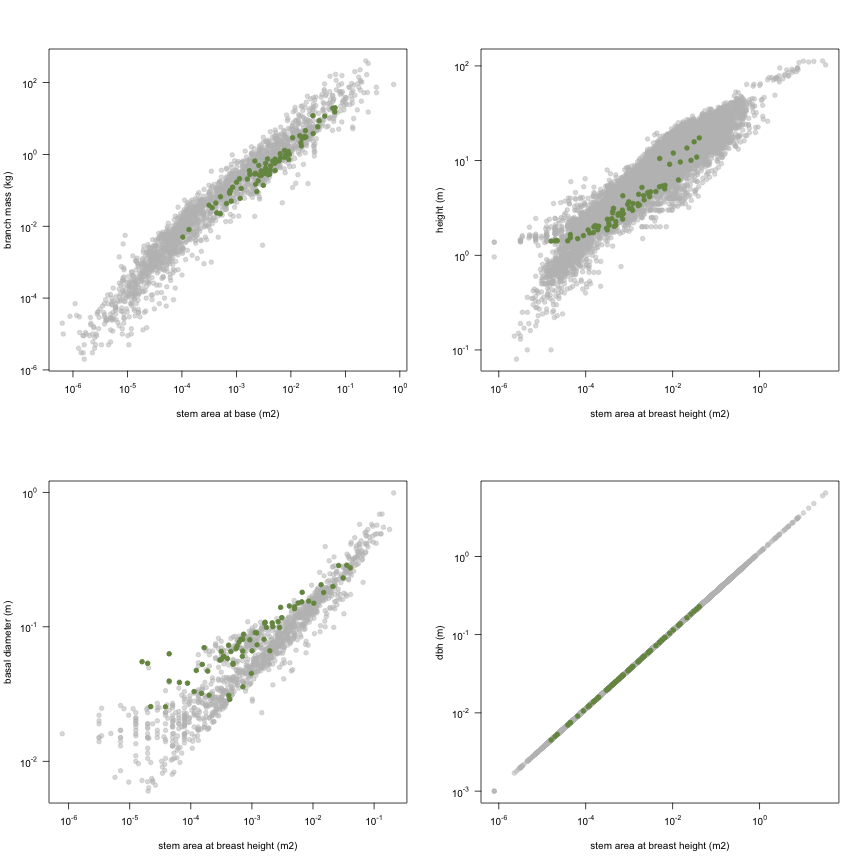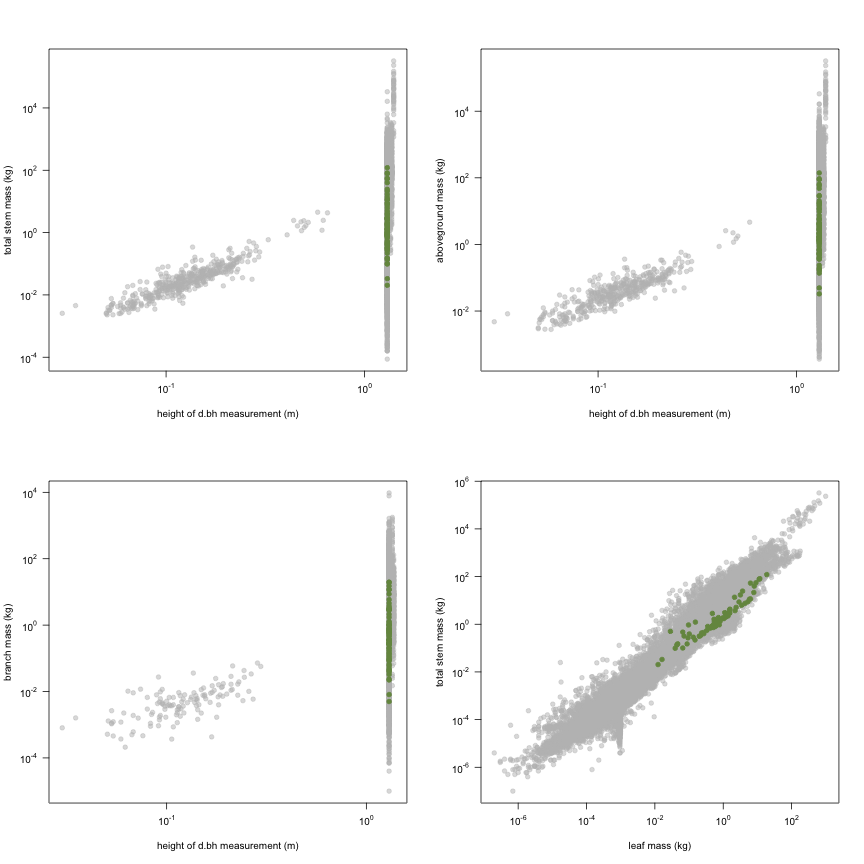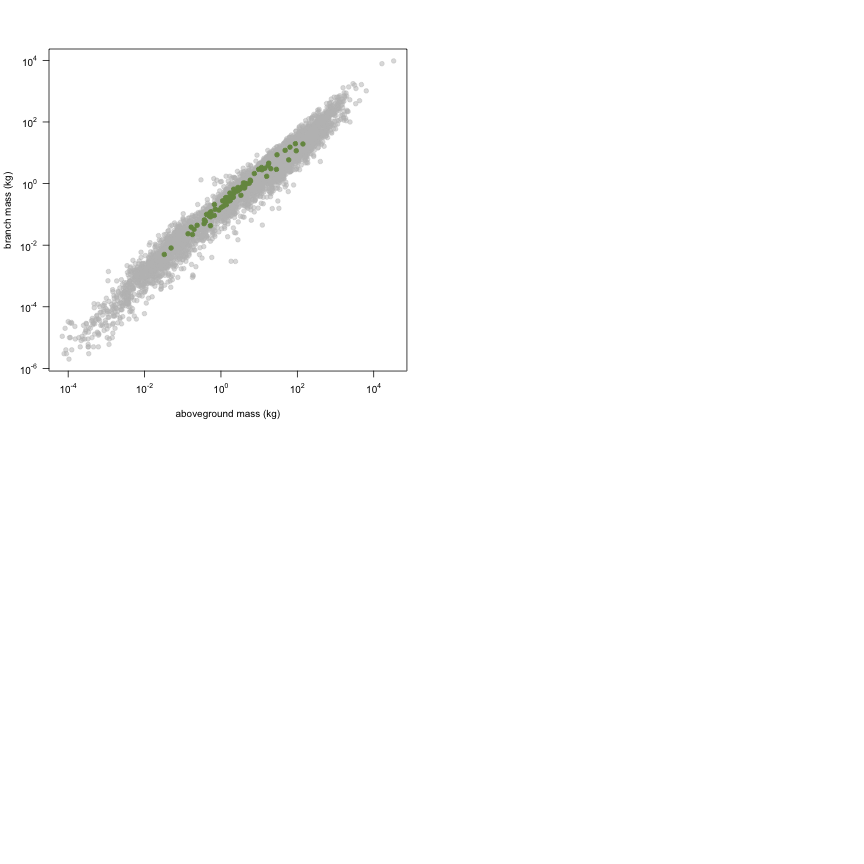-
Notifications
You must be signed in to change notification settings - Fork 19
Haruki1979
Data contributor: Masae I. Ishihara, Hajime Utsugi, Hiroyuki Tanouchi, Tsutom Hiura
Email: masaish.n@gmail.com
Address:
- Graduate School for International Development and Cooperation, Hiroshima University, 1-5-1 Kagamiyama, Higashi-Hiroshima 739-8529, Japan
- Forestry and Forest Products Research Institute (FFPRI), 1 Matsunosato, Tsukuba, Ibaraki, 305-8687, Japan
- Hokkaido Research Center, Forestry and Forest Products Research Institute (FFPRI), Hitsujigaoka-7, Toyohira, Sapporo, Hokkaido, 062-8516, Japan
- Tomakomai Research Station, Field Science Center for Northern Biosphere, Hokkaido University, Takaoka, Tomakomai 053-0035, Japan
Citation: Haruki M (1979). 'Studies on the material biomass of Abies sachalinensis artificial forest.' Research bulletin of the Hokkaido University Forests, 36, pp. 147-247.
DOI:
Abstract:
The dataset includes records for 75 individuals from 1 species belonging to 1 family(ies), presenting 1 functional type(s), growing in 2 condition(s) within 2 major type(s) of habitat, with data included for the following variables:
| Variable | Label | Units | N | Min | Median | Max |
|---|---|---|---|---|---|---|
| latitude | Latitude | deg | 75 | 43 | 45 | 45 |
| longitude | Longitude | deg | 75 | 142 | 142 | 142 |
| a.stba | Stem area at base | m2 | 75 | 0.0001 | 0.0035 | 0.065 |
| a.stbh | Stem area at breast height | m2 | 68 | 0.000016 | 0.00071 | 0.041 |
| h.t | Height | m | 75 | 0.67 | 2.8 | 17 |
| d.ba | Basal diameter | m | 75 | 0.011 | 0.066 | 0.29 |
| d.bh | Dbh | m | 68 | 0.0045 | 0.03 | 0.23 |
| h.bh | Height of d.bh measurement | m | 75 | 1.3 | 1.3 | 1.3 |
| m.lf | Leaf mass | kg | 75 | 0.012 | 0.62 | 19 |
| m.st | Total stem mass | kg | 75 | 0.02 | 1.3 | 121 |
| m.so | Aboveground mass | kg | 75 | 0.033 | 2 | 140 |
| m.br | Branch mass | kg | 75 | 0.005 | 0.36 | 20 |

And locally within the country:

The sites sampled are:
| Location | Longitude | Latitude | Vegetation |
|---|---|---|---|
| Japan-Teshio Experimental Forest of Hokkaido University-1 | 142.0 | 45.0 | Boreal forest, Temperate forest |
| Japan-Teshio Experimental Forest of Hokkaido University-2 | 142.0 | 45.0 | Boreal forest, Temperate forest |
| Japan-Teshio Experimental Forest of Hokkaido University-3 | 142.0 | 45.0 | Boreal forest, Temperate forest |
| Japan-Teshio Experimental Forest of Hokkaido University-4 | 142.0 | 45.0 | Boreal forest, Temperate forest |
| Japan-Teshio Experimental Forest of Hokkaido University-5 | 142.0 | 45.0 | Boreal forest, Temperate forest |
| Japan-Tomakomai Experimental Forest of Hokkaido University-6 | 141.6 | 42.7 | Boreal forest, Temperate forest |
| Japan-Tomakomai Experimental Forest of Hokkaido University-7 | 141.6 | 42.7 | Boreal forest, Temperate forest |
| Japan-Tomakomai Experimental Forest of Hokkaido University-8 | 141.6 | 42.7 | Boreal forest, Temperate forest |
| Japan-Tomakomai Experimental Forest of Hokkaido University-9 | 141.6 | 42.7 | Boreal forest, Temperate forest |
| Japan-Tomakomai Experimental Forest of Hokkaido University-10 | 141.6 | 42.7 | Boreal forest, Temperate forest |
| Japan-Tomakomai Experimental Forest of Hokkaido University-11 | 141.6 | 42.7 | Boreal forest, Temperate forest |
| Japan-Tomakomai Experimental Forest of Hokkaido University-12 | 141.6 | 42.7 | Boreal forest, Temperate forest |
| Japan-Teshio Experimental Forest of Hokkaido University-13 | 142.0 | 45.0 | Boreal forest, Temperate forest |
The growing conditions of sampled plants was:
| Location | growingCondition |
|---|---|
| Japan-Teshio Experimental Forest of Hokkaido University-1 | plantation managed, field wild |
| Japan-Teshio Experimental Forest of Hokkaido University-2 | plantation managed, field wild |
| Japan-Teshio Experimental Forest of Hokkaido University-3 | plantation managed, field wild |
| Japan-Teshio Experimental Forest of Hokkaido University-4 | plantation managed, field wild |
| Japan-Teshio Experimental Forest of Hokkaido University-5 | plantation managed, field wild |
| Japan-Tomakomai Experimental Forest of Hokkaido University-6 | plantation managed, field wild |
| Japan-Tomakomai Experimental Forest of Hokkaido University-7 | plantation managed, field wild |
| Japan-Tomakomai Experimental Forest of Hokkaido University-8 | plantation managed, field wild |
| Japan-Tomakomai Experimental Forest of Hokkaido University-9 | plantation managed, field wild |
| Japan-Tomakomai Experimental Forest of Hokkaido University-10 | plantation managed, field wild |
| Japan-Tomakomai Experimental Forest of Hokkaido University-11 | plantation managed, field wild |
| Japan-Tomakomai Experimental Forest of Hokkaido University-12 | plantation managed, field wild |
| Japan-Teshio Experimental Forest of Hokkaido University-13 | plantation managed, field wild |
| Species | Family | Pft |
|---|---|---|
| Abies sachalinensis | Pinaceae | evergreen gymnosperm |
Sampling strategy: Sampling was conducted in 12 Abies sachalinensis plantations in Teshio and Tomakomai Experimental Forests, Hokkaido University, Hokkaido, Japan. Stand ages and the data of sampling were: stand 1-2: 11 years old, June and August of 1972; stand 3: 11 years, Sep. 1974; stand 4: 18 years, Nov. 1973; stand 5: 38 years, Sep. 1972; stand 6 : 9 years, Oct. 1974; stand 7-9: 12 years, Sep. 1972; stand 10: 35 years, Dec. 1972; stand 11: ca. 15 years, July 1976; 12: 30-34 years, July 1976. In addition, sampling was conducted in plot 13 in Teshio Experimental Forest, a naturally regenerated ca. 30 year-old A. sachalinensis stand in July 1976. Stand 11-13 were selected to study suppressed trees. Sample trees were selected either to cover size ranges or to represent the average size. Sample trees were cut at ground level. Tree height, height of the lowest living branch, and stem diameters at breast height were measured. Sample trees were then cut into two parts at the height of the lowest living branch. Crown was further cut into whorl strata defined by whorls. For each stratum, needles and branches were separated from the stem.
Stem cross sectional area: Estimated from stem diameter.
Height: Measured after trees were cut.
Biomass: Fresh mass of stem and needles + branches were measured for each stratum. Stems were oven-dried at 90 degC and weighted for dry mass. For stand 5 and 10, dry mass was estimated from fresh mass and the ratio of dry to fresh mass which was obtained from a disc collected for each stratum. Needle fresh mass and branch fresh mass of each whorl stratum were estimated from the needle+branch fresh mass and the ratio of needle to branch mass specific for each stratum. The ratio was estimated from subsamples taken from the stratum. Fresh mass was converted to dry mass by the stratum-specific ratio of dry to fresh mass which was obtained from subsamples. Amount of subsample for the conversion ratio was about 10 % of the total fresh mass within the stratum.
Other variables: M.I. Ishihara, H. Utsugi, H. Tanouchi, and T. Hiura conducted formal search of reference databases and digitized raw data from Haruki (1979). Based on this reference, meta data was also created by M.I. Ishihara. Species name and family names were converted by M.I. Ishihara according to the following references: Satake Y, Hara H (1989a) Wild flower of Japan Woody plants I (in Japanese). Heibonsha, Tokyo; Satake Y, Hara H (1989b) Wild flower of Japan Woody plants II (in Japanese). Heibonsha, Tokyo.
This is how the study Haruki1979 fits in the entire dataset (grey). each colour represents a species. A legend of species names with colours is included at the end for reports with 1 < n < 20 species.











